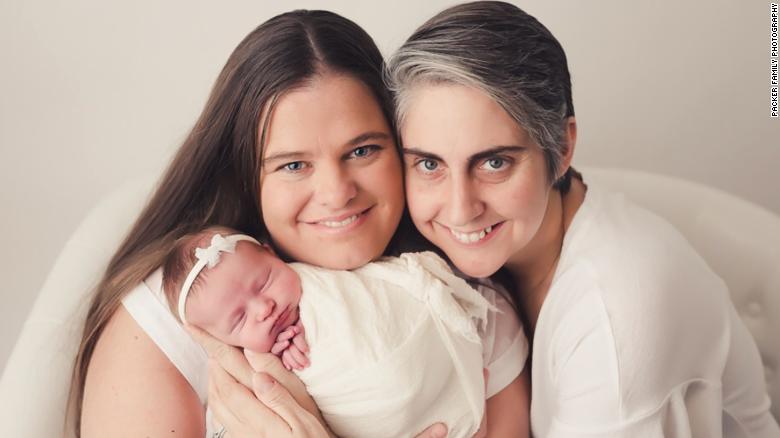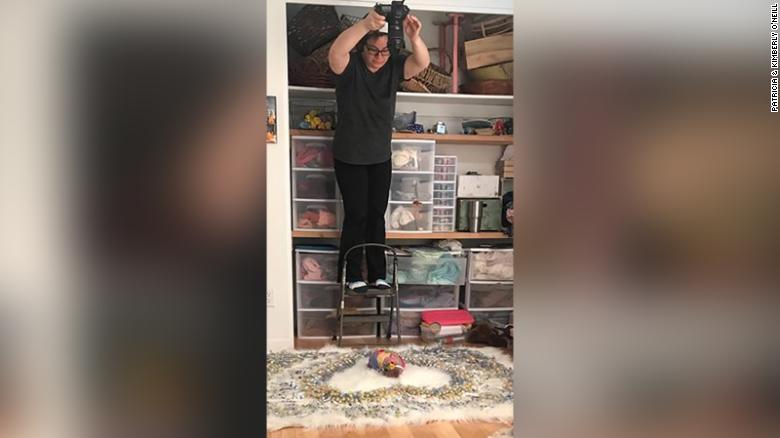Wearing a rainbow swaddle, the 2-week-old is encircled with hundreds of syringes showing her parents' IVF struggles.
The heart around her is made of the blood-thinner needles her mom used twice a day. The next ring shows the many IVF injections that her mom took.
After four years of trying, seven attempts, three miscarriages and 1,616 injections, the O'Neills say they are overjoyed to welcome their daughter to their family. London O'Neill was born on August 3.
The photo of London was only meant to be something personal for Patricia and Kimberly O'Neill, a reminder of their fertility journey. After almost 55,000 shares on Facebook, the photo has become a symbol of hope for others struggling with infertility.
"I hope that there's a couple out there that's going through what we are that can see that there's hope at the end of the tunnel," Patricia O'Neill told CNN. "There's a light and you just have to get there."
They fell in love and wanted to grow their family
Patricia and Kimberly met almost six years ago while both were working at a daycare. They fell in love and knew they wanted to have a baby together.
After a year into their relationship, they started trying to conceive in February 2014. Patricia, now 30, said she didn't want to narrow her window of having a child. During their fertility journey, they married in January 2017.
Patricia, who has a 7-year-old daughter from a previous relationship, always wanted to have a biological child. Kimberly has a 14-year-son of her own from another relationship. They decided Patricia would carry the child.
"We just thought it would only take going into a fertility clinic and nine months later, we'd have a baby," Patricia said. "It just didn't happen like that for us."
The Sun City, Arizona, couple saw a fertility doctor and tried two rounds of intrauterine insemination, neither of which resulted in an embryo. Next they tried two egg retrievals and began the IVF journey with a new doctor. The second attempt gave them five embryos.
The hope of finally having five chances to have a baby dwindled with each implantation. The couple lost baby one at six weeks. They lost baby two at eight weeks.
Something was wrong and Patricia's doctor decided to do some genetic testing. She learned she had a blood-clotting condition called Factor V Leiden.
It's a mutation of a clotting factor in the blood, and it increases a person's chance of developing "abnormal blood clots," according to the Mayo Clinic. Women with this mutation have a higher risk of developing blood clots during pregnancy.
Knowing what was wrong, they tried the third embryo and it didn't take, Patricia said. After a month they tried the fourth embryo and were successful.
"We were excited. We went in to eight weeks in and we knew it was a boy," Patricia said. "We saw the heart beat and then we went at 11 weeks and the heartbeat had stopped."
Patricia said she was at her breaking point after losing their son.
"I was done and I couldn't do it anymore. But my wife and I, we started this journey together, and we decided we would always be together in the hard decisions and she wasn't done," she said.
They finally figured out what was wrong
The O'Neills couldn't bear the thought of discarding, donating or not using their last embryo. They found a new doctor, this time one who specialized in Patricia's clotting mutation.
They started seeing Dr. John Couvaras, a board certified reproductive endocrinologist and ob-gyn, in summer 2017. Patricia gave her doctor permission to speak with CNN about her case.
"She wasn't getting pregnant and moved to IVF and the embryo transfers resulted in miscarriages -- that's a huge red flag," Couvaras told CNN. He's been a fertility doctor since 1990.
Couvaras found a few more things beyond the blood-clotting condition that were making it difficult for Patricia to carry a baby, he said. She had inflammation markers, low vitamin D levels and an enzyme deficiency, all of which contribute to recurrent miscarriages, he said.
He prescribed Heparin shots twice a day. The blood thinner would help the baby get better blood flow, he explained.
"When people are struggling, there's an underlying medical problem," Couvaras said. He added that Patricia's condition is common in his world.
On their try with the fifth embryo, "God blessed us," Patricia said.
The O'Neills found out days before a family trip to Disney World. The baby didn't even have a heartbeat yet, she said.
"I wasn't allowed to ride on anything or even allowed to walk. I had to wear a mask the whole time," Patricia said. "We always feel her heartbeat was formed in Disney World."
The joy of being pregnant was followed by fear, she said. They had ultrasounds every two weeks and the technician soon learned to show them the baby's heartbeat first thing. "You really sit on the edge of your seat at every appointment," she said.
A photoshoot that was a long time coming
Kimberly O'Neill started looking at newborn photoshoot ideas as they started their IVF journey. She came across photos of babies surrounded by syringes and decided to save the needles from each injection.
"My wife saved every single needle that I injected, all capped and plastic seals around them and everything," Patricia said. "We didn't know how many shots we were going to have at the end of it and we thought it was going to work pretty quick."
The O'Neills spent $40,000 during their four-year fertility journey. Patricia works in the mortgage industry and her wife works at a bank.
They knew they wanted a photo of their baby that included all the syringes that it took to get to this point. Once they were far enough along with London, they contacted a photographer.
Newborn photographer Samantha Packer said she has taken dozens of photos of rainbow babies, which are babies born after a mother has lost a baby to miscarriage, stillbirth or infant loss.
The couple and Packer agreed the infant would be swaddled in rainbow fabric to represent the miracle of this rainbow baby.
Packer wanted to make a heart out of all the needles, but she didn't realize how many needles that was until the O'Neills brought them over. It took Packer more than an hour to meticulously lay out the syringes all pointing in the same direction.
"The heart symbolized ... that this whole painful journey was all to love a child," Packer told CNN.
When the O'Neills arrived for the shoot just one week after London was born, they saw the heart-pattern of needles and were overwhelmed, Packer said.
"They instantly started tearing up," Packer said. "I think that's why the photo resonated with so many people. The journey, the goal and the baby, it was a lot."
"As soon as I looked at the back of my camera, I thought it encompassed the beauty, the hardship and the love of it," she said. "It was all worth it."















EmoticonEmoticon